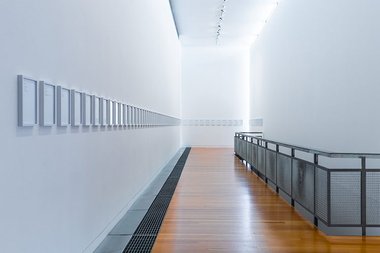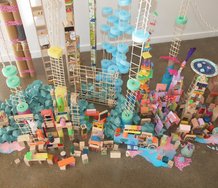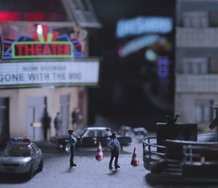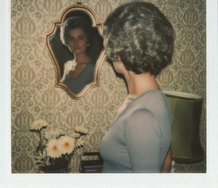Anna Knox – 17 August, 2020
I understand Friedman's ideas and those of the greater Fluxus project. I think the practice of levelling art and making it accessible to anyone, of tearing down the gallery walls, and so on, is important. But ultimately this exhibition was tightly locked inside those walls, truly accessible only to those who, in the first place would enter a gallery on a university campus, and, in the second, understand contemporary art and the context of the wider conversation about it. I barely qualified.
Entering the Adam Art Gallery Te Pataka Toi at Victoria University to see Ken Friedman’s 92 Events, the straight line of A4 papers in plastic Warehouse frames, evenly spaced and at eye height on the long white wall, promised something soothing. This won’t take much out of me, I thought. The repetitive nature of the pages, the whiteness, the simple typed text and prolific blank spaces would be easy to digest. I had read up on Fluxus and understood that the exhibition contained 92 defining examples of something called ‘event performances’ which, according to Wikipedia, seek ‘to elevate the banal, to be mindful of the mundane, and to frustrate the high culture of academic and market-driven music and art.’ In theory, I was enthusiastic.
I started at the first of the chronologically arranged works, Scrub Piece (1956), in which a six-year-old Friedman writes:
Go to a public monument
on the first day of spring.
Clean it thoroughly.
No announcement is necessary.
After the second (The Light Bulb - ‘Create and perform an improvisational drama…’) and third (Table Stack - ‘Build a stack of tables…’) I felt weary, considering the impending 79 texts, so abandoned chronology and wandered along the wall, reading at random. Mail a Chair (1967) instructed the reader to mail a chair to somebody. Christmas Tree Event (1964) said to take a Christmas tree to a restaurant and order it a coffee and talk to it. There were multiple other, mostly similarly absurd instructions for event performances, several relying on ‘in-jokes’ to be understood, such as Architect’s Showcase (1982) which commands the reader to: ‘Invite Nam June Paik, Charlotte Moorman, and Dick Higgins to perform anything twice.’
I began to feel the long white line of glass-encased A4 pages, and the didactic, type-written text inked onto them, as a great cold yawn. Stifling, like a shut-up hotel room. Brutal to my mind. Too bright and clean. Devoid of any life-like substance or suggestions of impression or imitation, and lacking any aesthetic but that of paint stripper. Was this art?
I searched for comparisons. If I were to compile 92 pages of ideas I have had over the years for novels in a book and publish it, would it count as literature? Friedman refers to these works as ‘scores’, but if a composer uttered 92 sentences to describe a piece of music she heard in her mind, could an orchestra still perform it? Would she be considered to have composed the music, or have just described it? Would it be music? If a dancer drew 92 over-sized sketches of his jumps and leaps and turns, and held them up to a packed auditorium, would that audience be satisfied?
I understand (somewhat) Friedman’s ideas and those of the greater Fluxus project. I admire them. I like them. I think the practice of levelling art and making it accessible to anyone, of tearing down the gallery walls, and so on, is important. But ultimately this exhibition was tightly locked inside those walls, truly accessible only to those who, in the first place would enter a gallery on a university campus, and, in the second, understand contemporary art and the context of the wider conversation about it. I barely qualified.
Reproducibility is a key aspect of 92 Events. Each of the 92 files is fully available to anyone who wants to acquire them and print them out, and enact them, if they choose. Galleries are instructed by Friedman to make their own decisions about how many to display, and whether ‘only as text, or also realised in objects, environments, or performances,’ as Stephen Cleland explains in the Adam’s accompanying leaflet.
It was timely that on the evening after I saw (or read) 92 Events news broke that the drawing which won this year’s Parkin Prize had been found to be a direct imitation of another drawing of the same name created in 2019. But Poppy Leckner’s Forward Slash was not a plagiarising of Colorado artist Joel Swanson’s Forward Slash. It was just that the idea of pressing the slash key lots of times onto a piece of white, A4 was very reproducible, and perhaps not that original. (Another similar drawing, Dattilograme Typwriter Poem by Maurizio Nannucci, was produced in 1964). Friedman’s 92 Events asks whether uniqueness matters, and I think it does. There is zero possibility that a Pulitzer Prize winning novel could be identically and accidentally reproduced two years later, or an award-winning symphony, or a pop album.
Uniqueness is one thing, and ability is the other that for me distinguishes an artwork from an interesting idea. I could look again to literature or music for comparisons, but in this case visual art provided one. Reaching the final three events in the series, I glanced over the railing next to them. Below me on the mezzanine, laid out on black Meccano-like shelving, were a hundred or more ceramic head-sized heads, each uniquely made, I later learned, by the artist, Julia Morison. The relief I felt registering the solidity and thing-ness of those heads, after the airiness of the 92 Events, was palpable. My body relaxed, and my mind followed as the heads seemed to gather in my own fragmented, strained, too-bright thoughts and contain them. I abandoned 92 Events and went downstairs for a closer look.
Incredibly, Morison has sculpted 115 (?) of these individual heads since 2011. Every one of them is different and though in a room together they echo each other, each also stands alone. And I could not have made a single one of them. 92 pages of instructions for event performances I might write in a couple of days, even forging some of the subtle, poetic connections noticeable in 92 Events but does that make me an artist? And if it does, if that is the point, what value does an artist, or art have? I think an artist should be capable of something I am not, to possess a differentiating talent or skill. In Head[case] there is no doubt that Julia Morison is such an artist. Whereas the inherent suggestion of 92 Events is that by reading the events, by potentially enacting them, or imagining enacting them, we all are artists. But if that is the case, who is Friedman? Which is, of course, exactly the kind of questioning that Friedman is hoping to raise.
As a writer, something in me is also uncomfortable with the use of text in, or as, visual art, and my disenchantment with 92 Events is finally connected to this. When I write I am always reaching for what is beyond the language—for the art that is there. I try to get at it with words, even though it is beyond words. Language is a poor tool, though, and music, dance, and visual art do much better at accessing and communicating what it is I’m reaching for. So when an artist reduces their visual work, with all its potential, to language, I feel cheated of what they might otherwise have given me.
The argument will be made that this exhibition needs to be understood in the context of the greater Fluxus project, and of Friedman’s intent with this particular show, available for free to anyone to print and exhibit anywhere, but does it? As a latecomer to the contemporary art scene, I have a partly sceptical, partly bewildered understanding of conceptual art, and so I am always looking at an exhibition for something tangible, for what makes the artwork art, beyond its intellectual standing or its part in the academic and theoretical arguments about art. For me, any artform, whether visual, language, music, sculpture, or performance, seems somehow fraudulent if its only effect is to interrogate or generate meaning. There has to be something else.
Anna Knox

 Advertising in this column
Advertising in this column Two Rooms presents a program of residencies and projects
Two Rooms presents a program of residencies and projects



This Discussion has 0 comments.
Comment
Participate
Register to Participate.
Sign in
Sign in to an existing account.